The first time I learned about Chinese chicken on a stick, was when I first moved to a major city. I absolutely fell in love with it. However, a broke college student, I couldn’t afford to eat out as often as I liked and had to figure out how to recreate the recipe at home. With a little bit of experimentation, I finally nailed it!
In this post, I will show you the Chinese chicken on a stick recipe – I also show you the different ways you can prepare your chicken and provide plenty of guidelines too!
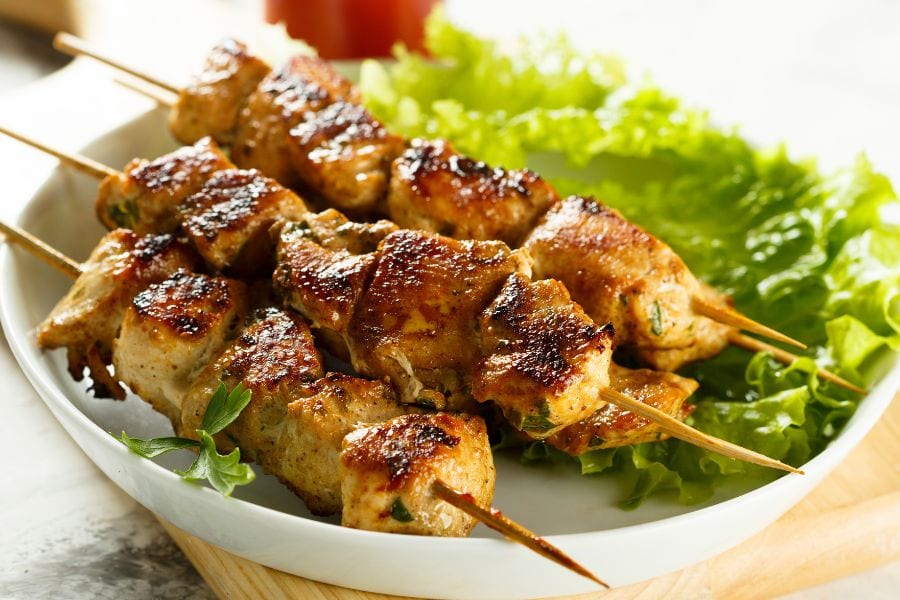
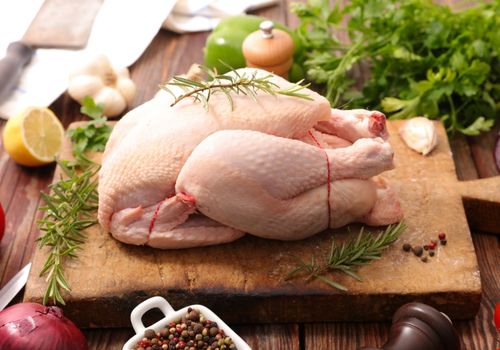
Soak the bamboo skewers in water.
Add all of the ingredients to a bowl. Use a whisk to combine all of the ingredients. Make sure all the cornstarch has broken up and dissolved in the liquid.
Slice the chicken thighs into chicken strips of similar width and thickness. Then, cube – make sure that the cubes are around the same size. This will allow them to cook at a similar rate.
Place the cubed chicken thighs in a glass container or a Ziploc bag.
Give the marinade a stir to ensure that the cornstarch hasn’t settled at the bottom. Then, pour the marinade into the bowl or the bag.
Make sure that the marinade is equally coating the cubed chicken thighs. Seal the bag or the bowl and place it in the refrigerator.
Allow the chicken to marinate for between 1 hour to 4 hours. If you have the time, let the chicken marinate for up to 24 hours.
Preheat the grill to 350 F.
Take the cubed chicken thighs out of the refrigerator.
Thread chicken onto a skewer, making sure to leave some space between each cube. Retain the teriyaki sauce or the marinade to use later.
Repeat until all the chicken has been skewered.
Place the skewered chicken on the grill.
Cook until the internal temperature of the chicken registers at around 80 degrees F.
Use a pastry brush to baste the Chinese chicken on a stick. Then flip over.
Baste the other side of the Chinese chicken on a stick as well.
Cook until the internal temperature registers at 165 F.
Take the Chinese chicken skewers off the heat and place them on a tray or plate.
Serve over jasmine rice or brown rice.

I do prefer cooking my chicken on a stick on a grill. However, if you don’t have a grill or want to use another option, this is fine.
Here are some guidelines for cooking chicken on a stick on other heat sources:
Place a grill pan or a skillet on the stove. Turn on the heat to medium heat. Brush on some oil onto the pan and wait for it to heat up.
Place the skewered chicken onto the pan. Cook chicken for 6 to 8 minutes. Brush on some teriyaki sauce. Flip the skewers over and brush on some more sauce.
Cook until the internal temperature reaches 165 F.
Preheat the oven to 400 F.
Spray a baking tray with oil or line it with paper. Arrange the skewers on the tray. Make sure to keep some space between each skewer.
Place in the oven and cook until the internal temperature reaches 165 F. This should take around 15 minutes.
At the halfway point, flip the skewers over. Then, continue to cook until done.
Set the temperature to 400 F.
Place the chicken skewers in the basket. Cook chicken for 5 minutes. Then, flip the skewers over and cook the meat for another 5 minutes.
Take out when the internal temp registers at 165 F.
Here are some of the things that you should know about when making this Chinese chicken on a stick recipe:
You may be wondering if you can make certain substitutions to the recipe. Here is a breakdown of some that you can make:
I know that for a lot of people, chicken breast is the go-to when making chicken recipes. Chicken breast is lower in fat and has fewer calories. Due to this, it is considered the healthier option.
Personally, I prefer chicken thighs when making Chinese chicken on a stick or teriyaki chicken. This is because chicken thighs are the far more flavorful option. In turn, they take your Chinese chicken on a stick to another level.
Also, as chicken thighs are dark meat, they aren’t as prone to drying out during the cooking process. Make sure to always use boneless skinless chicken thighs as this will take the hassle out of the prep work.
However, if you aren’t a fan of chicken thighs, don’t worry. The recipe can easily be prepared using chicken breast for better nutrition, calories, and fat content.
If you are using boneless chicken thighs, though, make sure to use boneless chicken breast as well.

If you are not very familiar with using soy sauce, then it is easy to imagine that all sauces are the same. In this case, you may feel comfortable swapping out the light soy sauce with dark soy sauce.
This is something that you should avoid doing.
See, the light version of the soy sauce is all about salty, umami flavor. The dark soy sauce, on the other hand, is more about adding color to the dish. It also has a slightly caramel-like flavor to it.
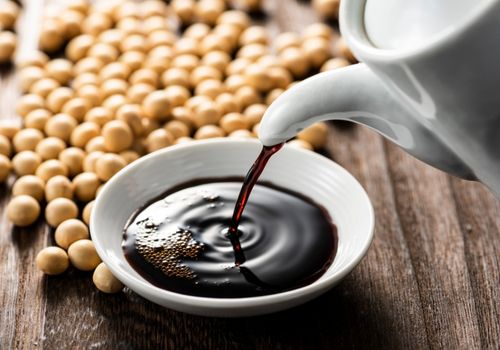
If you don’t frequently make Asian inspired dishes, then you may not have rice vinegar on hand. Well, there is no need to worry because apple cider vinegar is a near perfect match for rice vinegar.
So, you can easily swap out one for the other.

As you will see from the marinade, I have used both honey as well as brown sugar. You may be wondering why – aren’t they essentially the same thing?
Well, honey is quite a bit sweeter than sugar. I have also found brown sugar to have a slightly deeper flavor which I find helps to round out the sauce.
However, if you don’t have one or the other, then feel free to use all honey or all sugar in your recipe.
If you are only using sugar, though, make sure that all the crystals are fully dissolved before adding them to the chicken.

Personally, I find fresh minced garlic to be the perfect addition to the Chinese chicken on a stick marinade or teriyaki sauce. It just brightens it up and adds a more complex flavor to the mix.
That being said, if you want to make this recipe fuss-free, then you can use garlic powder instead. In fact, I would say that garlic powder is a good option if you are only marinating the chicken thighs for a short period of time.
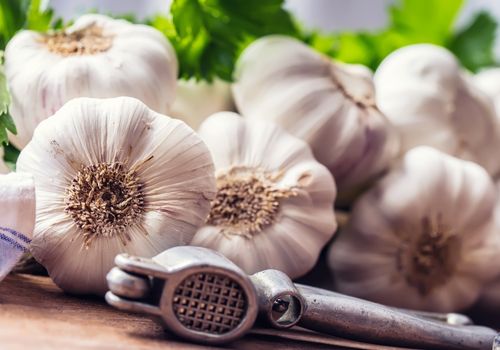
As with the garlic, I do prefer the fresh ginger to the dried version. It adds a zing to the sauce and really kicks things up a notch.
If you are short on time or can’t find the fresh version, though, then go ahead and sub in ginger powder.
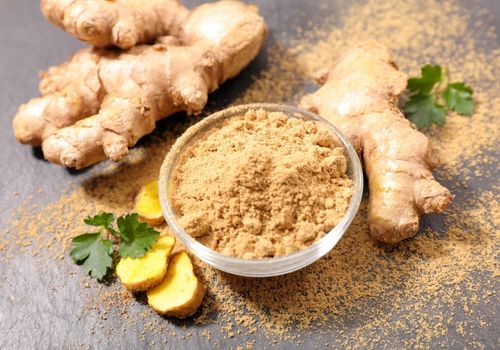
I know that a lot of people find this task pretty daunting. After all, most boneless chicken thighs and boneless chicken breasts tend to be pretty uneven in size and thickness.
It is due to this that you should inspect the boneless chicken thighs or breasts before buying them. Whenever possible, look for ones that have an almost even thickness throughout. This makes it a lot easier to cut them into slices and cubes with similar dimensions.
As you are slicing into strips, try to make sure that each strip is of a similar width. The same logic should be followed when cubing the boneless chicken thighs.
If you find that some pieces are smaller or larger than the other, put the larger pieces on one skewer and the smaller ones on another. This way, it should even out.
This is something that I get asked a lot about. Truthfully, the longer that you can marinate the chicken on a stick in the teriyaki sauce, the better.
Not only does the meat absorb all that delicious flavor, but your chicken on a stick is also a lot more tender. This is because the soy sauce and the vinegar have had time to tenderize the meat.
If you are really short on time, then I would ensure the chicken marinates for at least an hour. If you have a bit more time, then go ahead and leave the chicken in the sauce for about 4 hours.
If you are a fan of prepping your food well ahead of time, then I would suggest leaving the chicken to marinate for up to 24 hours.
Just remember to always refrigerate the chicken while it is marinating. This is especially important if you are planning on marinating the chicken for longer than an hour.
The other thing is to keep the chicken tightly sealed. This way, no other odors in the refrigerator will invade your chicken.
Now, keep in mind that you want each piece to be marinated equally well. Due to this, make sure that all the chicken is properly covered by the marinade.
If you find that this is not the case, then try separating the marinade into two glass containers or two Ziploc bags. This may result in a more even marinade.
This might seem like a side note but this isn’t the case at all. If you are grilling your teriyaki chicken skewers, then it is important to soak the sticks ahead of time.
This is so that they will not burn while they are on the grill.
Try to soak the skewers for a minimum of 30 minutes. If possible, though, soak them in water overnight as the skewers do take a long time to absorb the water.
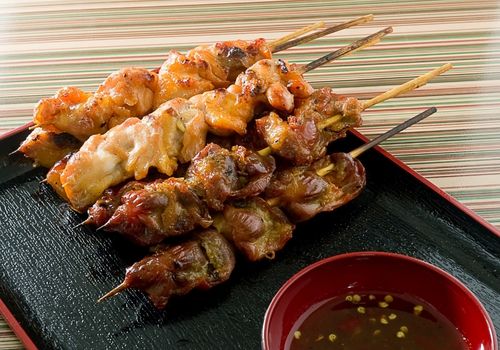
I do set the grill temp to medium heat as I have found that this strikes the right balance between moistness and flavor.
However, keep in mind that even dark meat cooks rather quickly. So, be vigilant about your skewers while they are on the grill. This prevents them from burning.
If you are worried about the chicken on a stick burning, then set the temperature to low. However, steer clear of high temperatures as they will just dry out your meat.
Now, you may be wondering why on earth you need to check the internal temp for bite sized cubes. Isn’t it better to stick to the time?
No, when it comes to bite sized cubes, it is best to check the internal temp. It is the best guideline to know precisely when the meat is done.
If you have followed my tip to thread chicken onto the skewer according to size, then checking just a few pieces is enough.
As you will have noticed, I have talked about basting in this chicken on a stick recipe. I like to lightly brush on some of the leftover marinades.
This helps to create a stickier result and also adds a little more flavor to the meat. I would definitely encourage you to use this trick if you have only marinated the chicken for a short period of time.
If you like your chicken even stickier, then consider basting it a few more times during the cook.
Well, this is all that you need to know about the Chinese chicken on a stick recipe! As you can see, it is fairly easy for you to make. You just need to know what special ingredients to use and what tricks are required to pull off the perfect dish.
Even if you are a beginner cook, this is the recipe that is going to quickly become one of your favorite meals!